One of the best ways to encourage sales is to create a sense of urgency, a feeling that your audience must purchase something now or miss out on some kind of reward. In this guide, I’ll show you how to create a countdown email campaign that builds urgency around a specific product or event to drive sales.
To accomplish this, I’ll explore:
- What a countdown campaign is + when to use one
- Examples of high-quality countdown emails
- How to structure your countdown email campaign
- The thing about countdown timers
When you’re finished reading, you’ll have everything you need except an occasion to count down to!
What is a countdown email campaign?
A countdown email campaign is a series of three or more emails counting down to a specific event. Each email builds on the last one, increasing the sense of urgency and sometimes also offering additional incentives to win over people who are debating a purchase.
There are several occasions when you might use a countdown campaign:
- In the lead-up to a product release
- When a limited-time offer is about to run out
- When you’re selling tickets for an event happening on a specific date
- In the lead up to a holiday sale
- If you’re counting down the days until the end of a sale
- If you’re only accepting people into a specific program or course until a certain date
- When a product/service is going to stop being produced or sold after a specific date
- When a product/service is going to increase in price after a specific date
And these are just the opportunities I’ve thought of; countdown email campaigns can be used to promote anything happening on, before, or after a specific date.
Countdown email examples
1. Casper
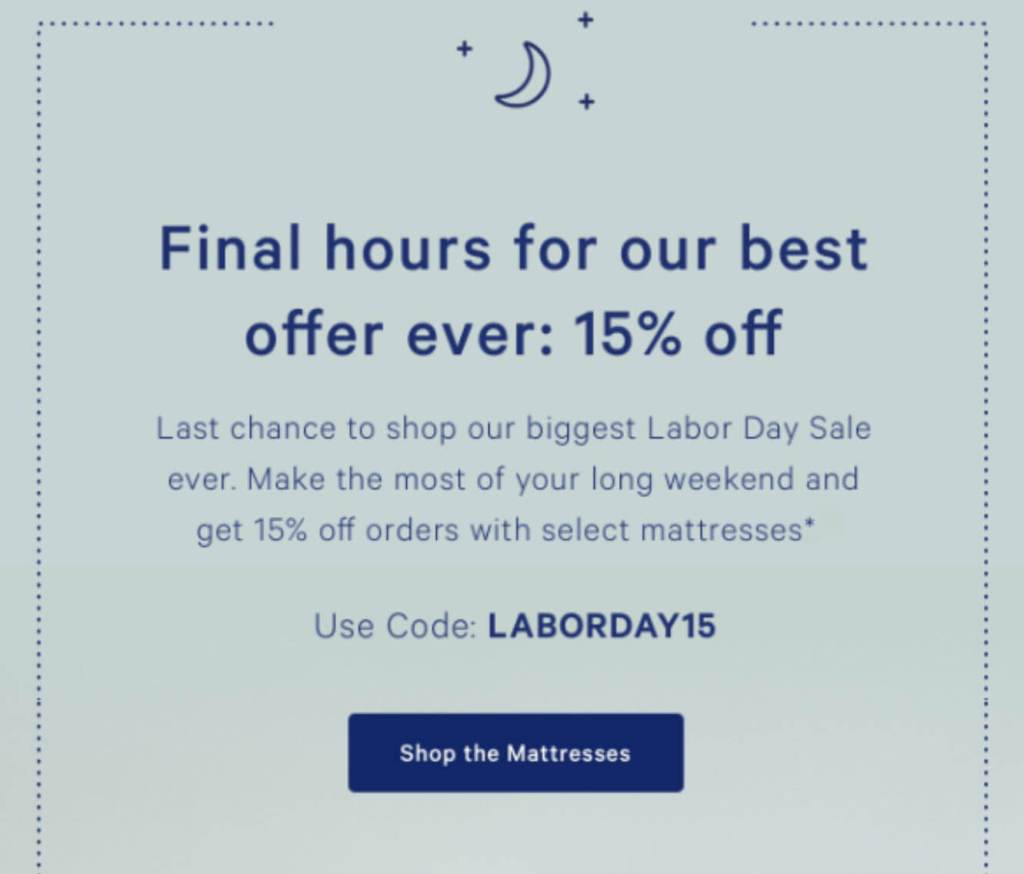
This countdown email from Casper is great for a couple of reasons:
- The email is visual. The most important information, the amount that users can save, is in big, bold letters, and the call to action is placed in a large button. Subscribers can see all of the information they need, including how to take action, in a glance.
- The email is short. Subscribers don’t need to scroll or read large blocks of text to reach the call to action.
- The call to action is specific. The button asking you to “Shop the Mattresses” tells you exactly what Casper wants you to do.
The language and branding also reflect the company’s personality, ensuring that subscribers have a consistent experience when they engage with Casper marketing campaigns.
2. Distributed

This email works for similar reasons to the Restream email: the content is highly visual, the text is short, and the call to action is highly specific.
However, the full email is more like a landing page. There are multiple sections, each with its own information and call to action.
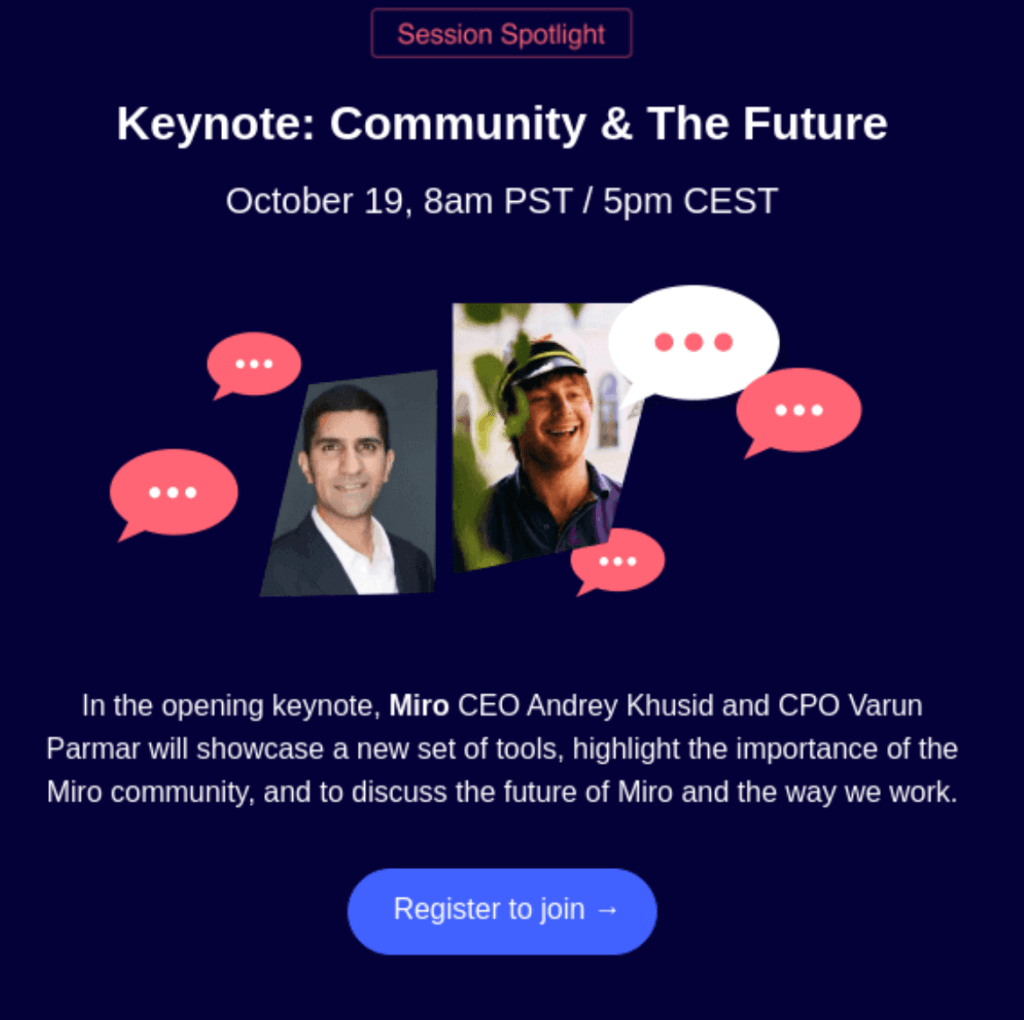
This approach works because there’s a lot to say about a conference like the Distributed 2021 event. You can highlight different panels, different guests, and other aspects of the event experience. A similar approach could also be used to highlight different uses for a specific product or multiple benefits provided by a specific service. I do recommend that you use this approach sparingly though; the average person receives over 125 emails per day, so they don’t want to spend a lot of time on any individual message.
3. Clearout
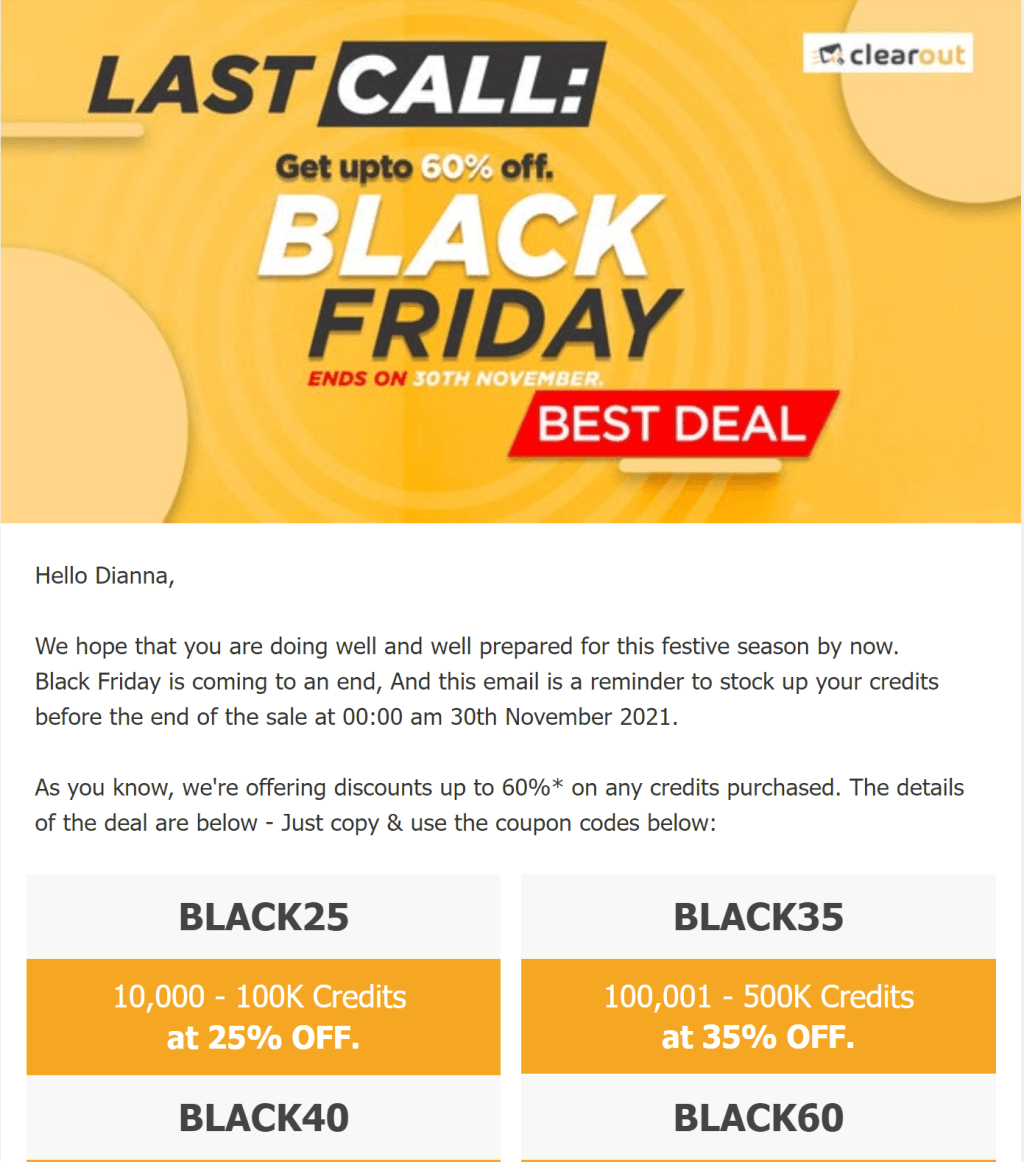
This Clearout countdown email is another email that uses striking visuals to direct users towards the spaces where they can take action. The coupon codes in particular are large and use contrasting colors to make them, and the information about each coupon, highly visible.
The size of the coupon codes does mean that the first buy button appears below the fold (after a user scrolls down), but in this case, the quality of the discounts is enough to convince people to scroll down.
How to create a countdown email campaign
1. Establish your goal
You probably already have a goal for your countdown campaign: to sell a specific product or service, make a specific number of sales in a store-wide clearance event, or get people to sign up for an event. For true success, however, you’ll want to get specific about the number of sales you want. This will help you create focused content and make it easier to measure the results when a campaign is finished.
Generally, I recommend setting the goal for a countdown campaign as a percentage. This means that your goal doesn’t become too small if you receive an influx of subscribers or become unachievable if you lose a bunch.
What is a reasonable goal?
According to Barilliance, the average conversion rate for email marketing campaigns was 15.22% in 2021. However, that doesn’t mean every business should aim for a 15% conversion rate. There are a few factors that can impact the conversion rate of a specific campaign:
- List hygiene. If you haven’t cleaned your list in a while, inactive and junk email addresses can reduce your engagement and conversion rates. You might also be wasting money by paying to keep contacts you don’t need, so if you haven’t cleaned your list in over 12 months, take a look at MailPoet’s list of compatible list cleaning tools.
- The value of your offer. People are more likely to take action when there’s a clear benefit, and a more significant benefit will win over more people. This means that you can expect a higher conversion rate on a 15% off sale than on a 10% sale. And increased value doesn’t always mean an increased discount, either. A new product sold at full price can net more sales than an old product offered at a steep discount.
- The cost of taking action. If you’re not a luxury brand that caters exclusively to the wealthy, cost will probably be a factor for your subscribers. And cost isn’t always money, either. If you’re selling tickets to a week-long event, people might not buy in because they’re not available for that long or during that particular week. In other words, people are less likely to take action if they need to commit significant resources to something.
- The quality of the campaign. If your campaign is difficult to read, doesn’t look good on mobile devices, or doesn’t present your offer in a clear and compelling way, people are more likely to delete your email without taking action.
If you’ve run similar sales before, you can also use your email analytics to get an idea of how well they perform with your unique audience.
2. Plan the structure of your countdown email campaign
Next, you’ll want to outline the overall structure of your campaign. This will help you know what to write in each email and ensure that your emails don’t become too repetitive.
Most countdown email campaigns should include at least three emails:
The “countdown begins” email
Your first email should announce what you’re counting down to and explain the basics: how long the countdown will be, why subscribers should take action, what action you want them to take, and how they can take that action. And you want to explain it all as quickly as possible, like this email from Everlane, which features a short introduction and one-sentence descriptions of the products available.
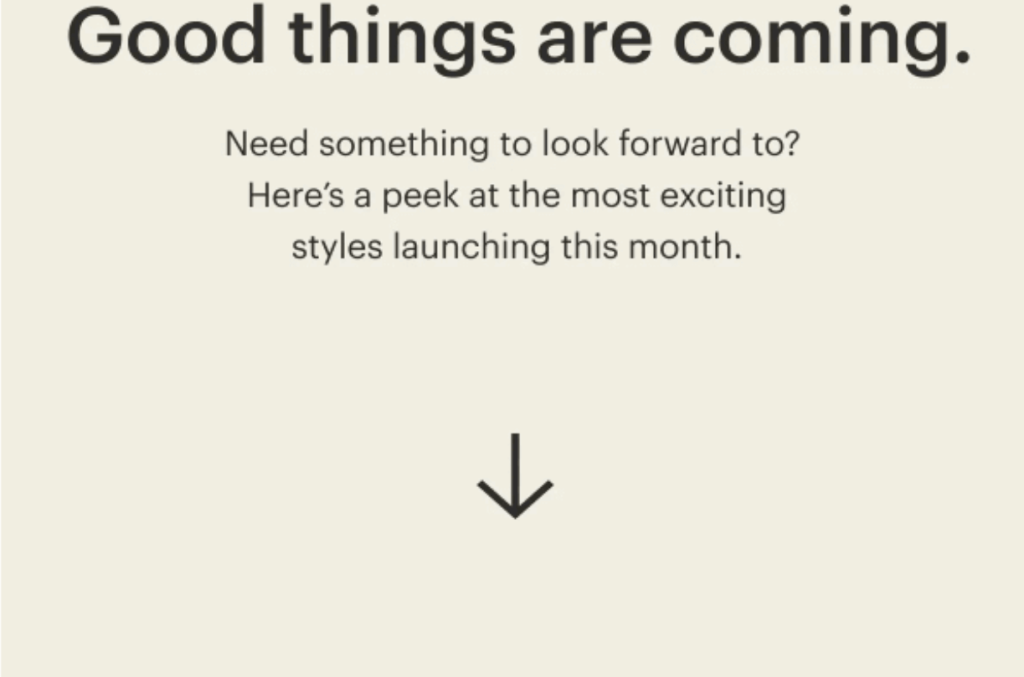
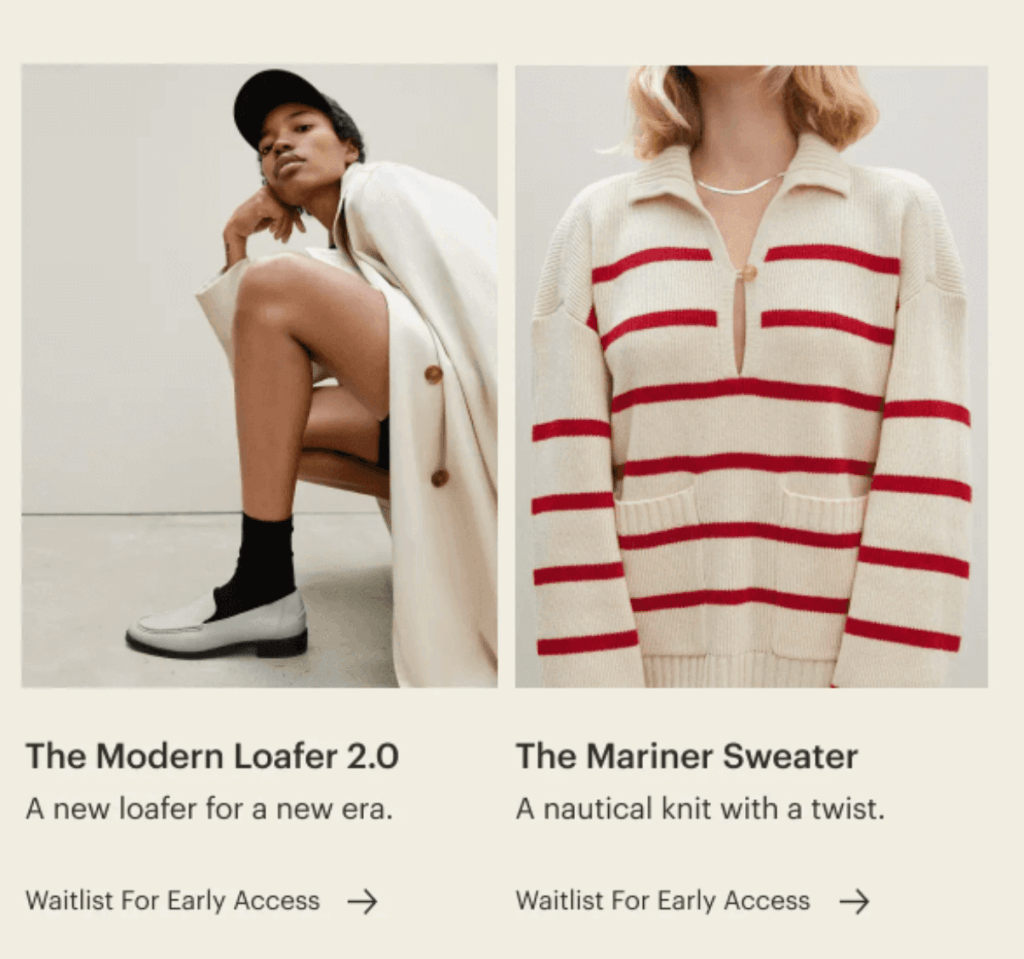
Pro tip: If you’re counting down to a product release or a sale, consider giving subscribers a secret link so they can take advantage of your offer before anyone else. This is a great way to reward subscribers for their devotion to your brand.
The “countdown is on” email

This email, or series of emails, goes out during the countdown itself. You can use this email as an opportunity to share more information about your offer, such as new images of your products in action.
If you do a multi-day countdown, you can send one of these emails every day, varying the emails by focusing on different aspects of the products/services on sale. For example, if you’re selling a six-week course, you might use each email to provide an overview of a specific lesson.
Running a multi-day countdown also means you can also use a different sales tactic in each email. For example, you might send one email that focuses on the discount itself, another that shows your products or services in use, and a third that shares reviews or testimonials.
The “last call” email
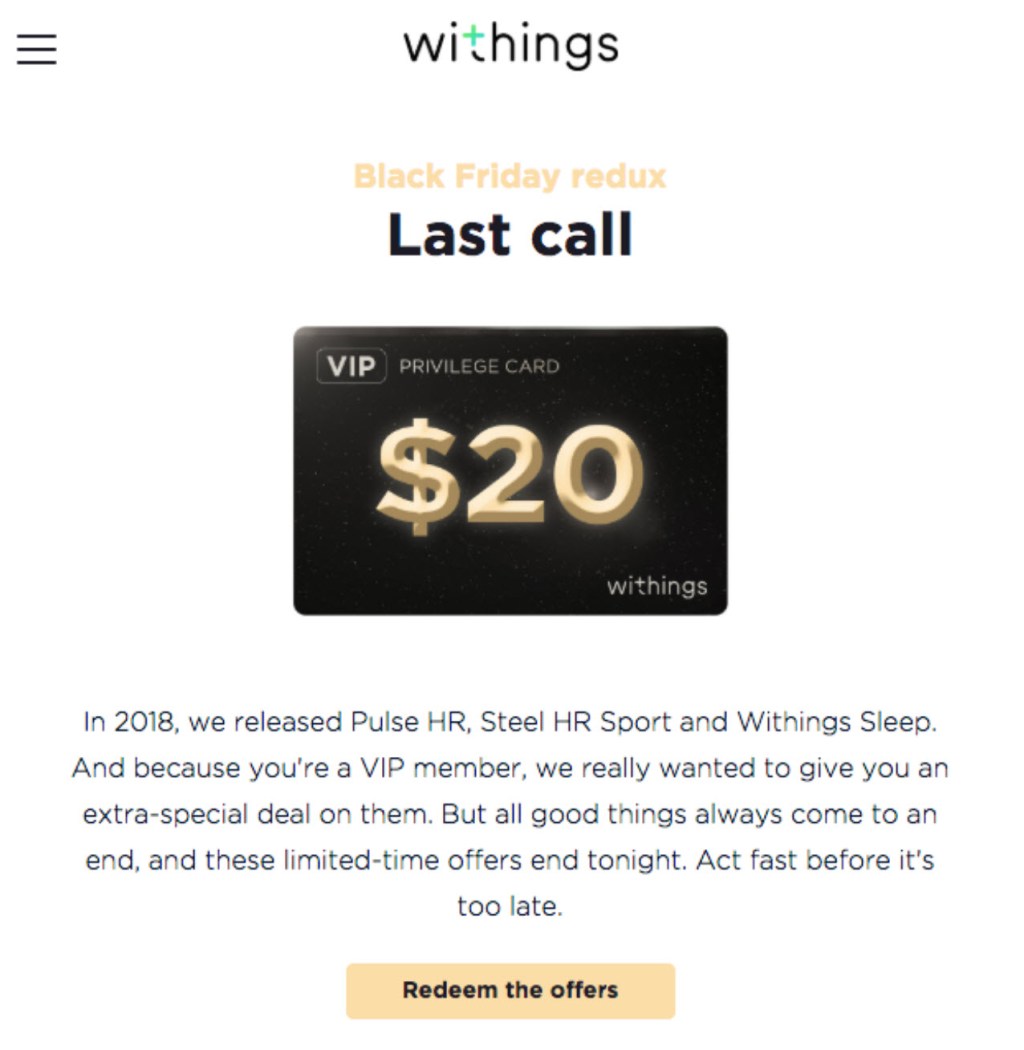
This email tells subscribers that they’re running out of time to take advantage of your offer, using words like “last call” and “final hours” to create an increased sense of urgency. If you’re running a multi-day sale, you might send this email on the morning of the last day; if you’re running a single-day sale, this email might go out in the final 4-5 hours.
3. Create your emails
With your plan in place, you’re ready to start creating the emails for your countdown campaign!
There are several guidelines you can follow to create effective countdown emails:
- Only use high-quality photos and illustrations.
- Use a single column layout to avoid visual clutter.
- Make sure your call to action is large and placed in a spot where subscribers will see it quickly.
- Use visual cues like arrows and people looking in a specific direction to direct subscribers’ attention to your call to action.
- Establish the details of your offer in the smallest possible number of words. People are more likely to read to the end if they can tell it will only take a minute.
- Use phrases like “buy now” and “don’t miss out” to increase the sense of urgency.
- Proofread everything, especially graphics! There’s nothing more embarrassing than misspelling a word in the banner at the top of your email.
You may also want to consider creating multiple personalized campaigns with segmentation. This is particularly useful if you sell a broad range of items since you can create targeted emails for people who have purchased similar items in the past.
4. Skip the countdown timer
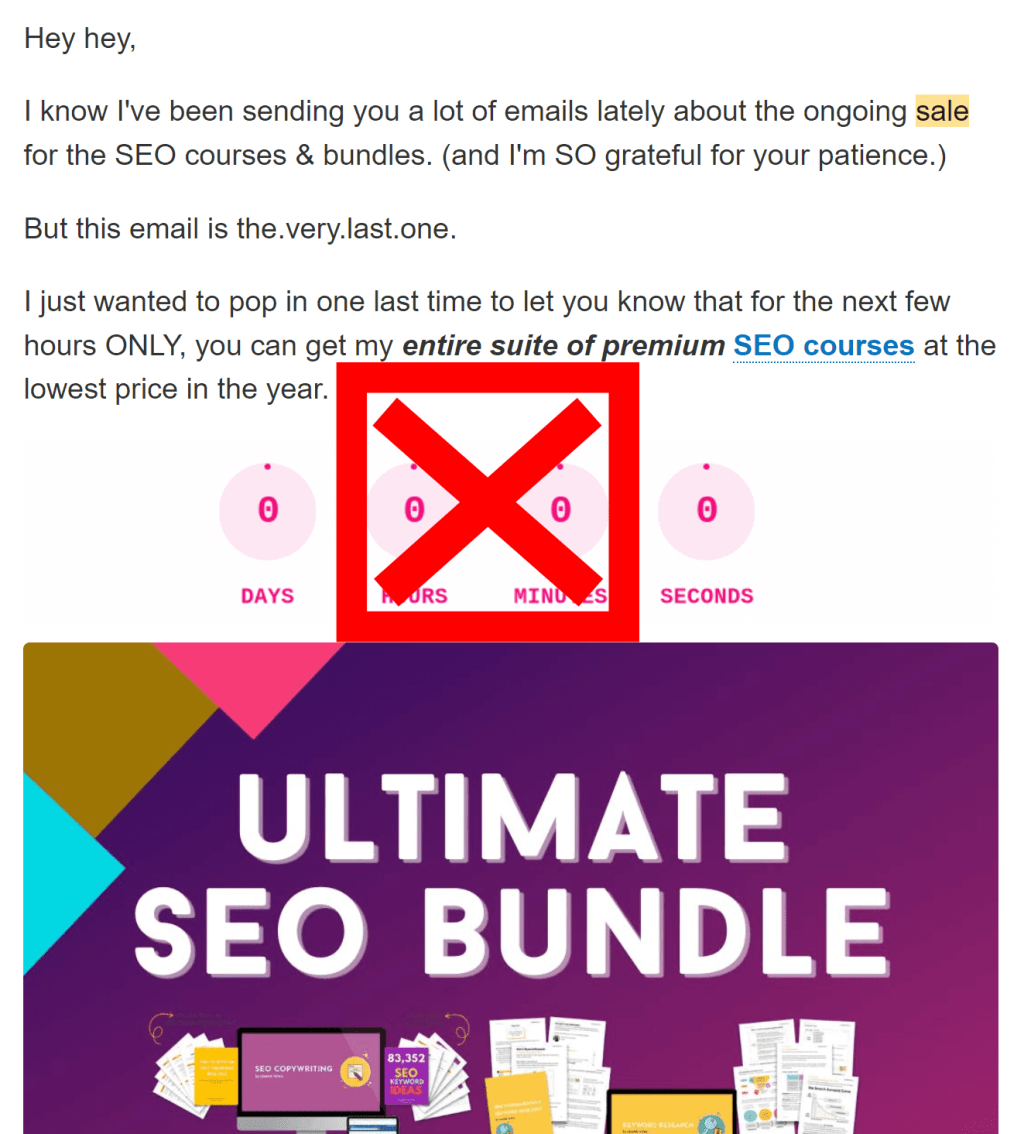
A countdown timer is an animation displaying the amount of time until your offer runs out. These timers count down in real time so that subscribers will see the seconds ticking by as they read your offer. This adds a visual layer of urgency, as well as showing subscribers exactly how much time is left in your sale/event.
In the past, countdown timers were one of the most powerful tools email marketers had for time-sensitive promotions. Unfortunately, the Apple iOS 15 update means that countdown timers no longer work in emails sent to Apple devices. Considering that 34.2% of all emails being opened in Apple Mail, this means that countdown timers won’t work for a significant portion of your audience. And there’s nothing like a broken email to convince people to unsubscribe from your list.
So, to make sure your campaign works for everyone, skip the animated countdown.
5. Create a series of countdown images
Instead of an animated timer, you can create a series of countdown images to emphasize the urgency of your promotion. You won’t be able to tell users exactly how many minutes they have left to take action when they’re viewing the email, but you can share how many days there are between when you sent the email and when the promotion ends.
The easiest way to do this is to create a single image template, then save different versions of that image with different numbers. The image doesn’t have to be complicated, either. Something as simple as a black box with “2 days” written inside in white text can attract viewers’ attention and convey a sense of urgency.
Your other option is to create a wholly new image for each day of the countdown. This is a great choice if you’re promoting a sale on multiple products, since you can use an image of a different product in each countdown email.
Final thoughts on how to create a countdown email campaign
A countdown email campaign is one of the most powerful ways to create a sense of urgency and encourage sales within a specific time period.
To make the most of your countdown campaigns, remember four rules:
- Get specific about your goal. Make sure that your goal is ambitious but achievable by basing it on your stats from previous sales campaigns.
- Plan the structure of your email campaign. Make sure you have a “Countdown begins”, “Countdown is on”, and “Last call” email scheduled. Depending on the length of your campaign, you might want to create multiple “Countdown is on” emails, each focused on a different aspect of the sale/event you’re counting down to.
- Create your emails with care. Use only the highest quality images, write concise copy that emphasizes the value you’re offering your subscribers, and proofread everything, including graphics.
- Use a countdown timer. A countdown timer is a visual aid that increases the sense of urgency created by the campaign itself. There are many tools that let you create these timers for free.
So what are you waiting for? Start planning your first countdown email campaign today!



